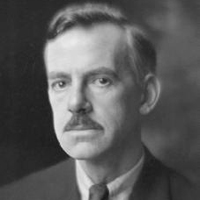Dramatic Technique in Desire Under the Elms
Dramatic technique of O'Neill deserves cautions attention from the side of the reader. His technique has assumed an experimental touch. O'Neill derived the classical myth of Phaedra and Freudian myth of Oedipus Rex. To transcend the limitation of realism O'Neill introduced the ancient Greek myth of Phaedra.

Eugene O'Neill (1888- 1953)
In this myth of Phaedra, Euripides has dramatized the horrendous consequences of the growing lust of the queen Phaedra for her stepson who is handsome and attractive. Within the framework of this myth O'Neill dealt with the fatalistic tragedy that befell on Cabot family. At first Abbie displayed unbounded lust for her step-son Eben. Over time this lust got transformed into an invaluable love. Apart from this myth of Phaedra, O'Neill has displayed his experimental touch with the myth of Oedipus complex. The myth of Oedipus - Complex, concludes that son is afflicted with the problem of mother-fixation. From similar problem of fixing Eben Cabot has suffered in Desire under the Elms. Eben feels as if his dead mother has been provoking him to take revenge upon Ephraim Cabot. Throughout the play Eben never appears as a son free from recurrent thoughts on his mother, who died of Ephraim Cabot's cruelty and neglect. As an aspiring modern dramatist O'Neill experimented with realism within the framework of myth. That is why, his experimental brand of realism has been duffed poetic realism. This technique of poetic realism gave the playwright a sole authority to sustain tragic magnificence.
In this play O'Neill exploited the technique mostly available in American folk Drama. Desire under the Elms fits precisely into the conventionalized pattern of American folk Drama. The following preoccupations of the characters in Desire under the Elms are in keeping with the tradition in American folk Drama.
? Cabot's sense of the earth as the source of his salvation.
? Eben's feeling of dislocation on the farm.
? Abbie's alien strangeness and her desire to come home are entirely in the tradition.
The elements of incest and adultery, the violence, the crudity, are all potentials of the pattern and in its thematic exploration of the nature of a 'hard' and 'easy' God. The play sees the land both as fertile and as sterile, as giving blessing and as demanding cruel service.
Again, viewed as a realistic narrative, the play contains elements characteristic of the naturalistic tragedy of Zola: those grim, depressing narratives of small men and women defected by societal and evolutionary forces which they cannot control. Yet, as with his use of Freud, O'Neill convinces his audiences that this story is in no way contrived to demonstrate a sociological point. Focusing less on the pressure of external circumstances, and more on the response to circumstances by the central characters, he strikes a balance between an exploration of the harshness of their rural world and the people themselves. Cabot, Eben and Abbie command sympathy, not because they are victims of forces which they can't control, but because they are capable of choice and responsibility. The choices they make are not forced upon them, but O'Neill, aware of the pressures of the farm on its people, is careful to show how the choices evolved, and permit audiences to draw conclusions about that world from the perspective of his characters' choice.
O'Neill has adopted the technique of including the pattern of recurring situations in this play. In nearly every scene one or two characters deliver speeches of similar content by or near the gate in front of the farmhouse. Thus the play opens with Eben's appearance at the end of the porch calling his brothers to the evening meal. Such situations get repeated throughout the play. The very inclusion of the recurrent situation adds an effect of concentration and compression.
With a view to prevent from degeneration the universal appeal of Cabot tragedy, O'Neill uplifted common speech in dialect to the level of poetic charm. To his level best he maintained unity of place so as to render action very compressed.
Desire Under the Elms Study Center
Introduction of Desire Under the Elms
Summary of Desire Under the Elms
O'Neill's Style in Desire Under the Elms
Symbolism in Desire Under the Elms
Image of Women in Desire Under the Elms
The Themes in Desire Under the Elms
A Conflict of the Dionysian and Apollonian Forces
 |
bachelorandmaster.com |